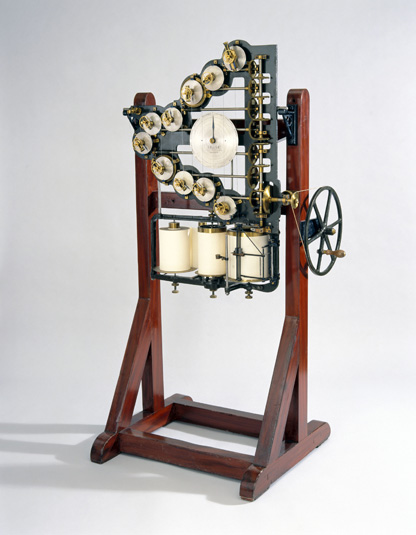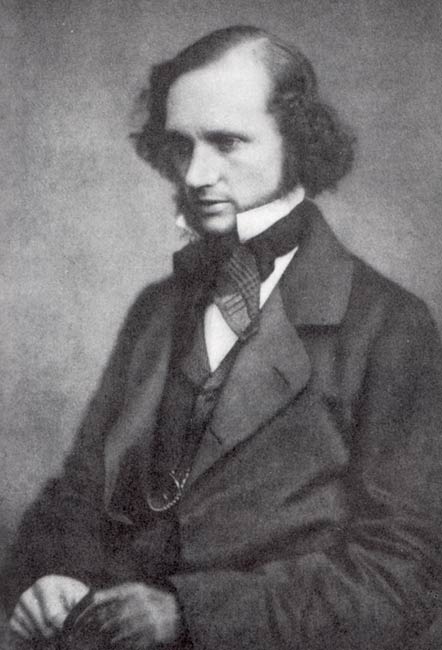
In the Science Museum in the South Kensington area of London is a gorgeous piece of hardware built from wood and brass, with wheels and cables and a pen poised over a roll of paper, and a big crank unfortunately inaccessible behind a lucite wall.
If you were able to turn that crank, the wheels would revolve, the paper would unfurl, and the pen would map out the future tides for a particular seaport, based on the initial settings of the wheels.
This Tide-Predicting Machine was designed by the renowned Scottish scientist William Thomson (later known as Lord Kelvin) and built in 1872. Today we describe such a machine as a "special-purpose analog computer." Analog computers comprise a neglected chapter in the history of automated mathematical computation, and the Tide-Predicting Machine is a fascinating early example.

There is obvious scientific importance in understanding the patterns behind the tides, and obvious commercial importance in predicting the tides at particular seaports. William Thomson pioneered what is known as the harmonic analysis of tides, and the mathematical techniques are still used today to provide accurate tidal information for seaports around the world.
Yet, there is a little more to the story....
When William Thomson began exploring the tides in the 1860s, he was also involved in a controversy over the age of the earth. Charles Darwin's The Origin of Species had been published in 1859, and Thomson was disturbed by the book's mechanistic and godless interpretation of evolution.
Thomson was convinced that the world was not old enough for evolution by means of natural selection to occur. He spent the last 40 years of his life in an obsessive quest to establish the age of the earth, and believed that the tides provided a vital clue.
The Tide-Predicting Machine is not only an interesting curiosity in the history of computing, but was also intended to be an armament in the 19th century Darwin Wars.
Computer of the Tides tells the story of the Tide-Predicting Machine in 350 pages of math-free prose with an historical scope that stretches over two centuries.
Videos
These two video presentations contain themes and ideas from Computer of the Tides. The presentations were given before an audience of programmers and therefore assume a higher technical level than the book.
Computer of the Tides:
Lord Kelvin's Machine to Disprove Evolution
From the clash of thermodynamics, geology, and evolution, the era of analog computing was born.
57 minutes.
When Worlds Collide:
Analog vs. Digital
We live in a universe whose natural processes are analog; yet we choose to model those processes on digital computers. Does this make sense? If digital technologies are so great, why do we increasingly hide digital computation under fluid and bouncy user interfaces? If analog computers are so lame, why are they also so clever, so elegant, and so fascinating?
56 minutes.
Chapter 1. Isaac Newton, MP
It is 1689, and England's Parliament is taking the unprecedented initiative in deciding who shall be the next King and Queen of England. This event will soon be known as the Bloodless Revolution and the Glorious Revolution, and in retrospect marks a crucial step in England's progression towards a secular democracy.
Representing Cambridge in the House of Commons is the 46-year-old Member of Parliament Isaac Newton. Just two years earlier, Newton published Mathematical Principles of Natural Philosophy, establishing the foundation of classical physics, and providing a decisive conclusion to the Copernican Revolution that dispaced Earth from the center of the universe.
Among the mysteries of the universe that Newton solves in this book involve the rhythm and nature of the tides, affected by both the gravitation of the Moon and Sun, and the centrifugal force of the moving Earth.
PDF: ComputerOfTheTides-Chapter01.pdf
Chapter 2. Fourier's Search for Heat
It is a hundred years later, and France is deep into its own revolution. Among the participants is the young Joseph Fourier, who like many revolutionaries of the period, is arrested several times and almost loses his own head.
In 1798 Fourier is recruited as one of the 167 scientists and 55,000 other men who go on an expediction to Egypt under Napoleon Bonaparte. Fourier is later a mentor to the translator of the Rosetta Stone, and assembles the 23 volumes describing Egypt and essentially founding the field of Egypotology.
Back home, Fourier researches the propagation of heat. In 1822 he publishes The Analytic Theory of Heat, a book that was to have a major influence over 19th century British scientists, and which established the Fourier Series for analyzing cyclical processes.
Chapter 3. Mistaken in its Age
Stretching from approximately 1750 to 1850 there occurs a scientific revolution as equally profound as the earlier Copernican Revolution, but which now involves time rather than space, based on observations of the Earth itself rather than the stars.
During this Geologic Revolution, the age of the Earth increases from thousand of years to perhaps billions of years. But this revolution does not occur without pain or controversy.
One of the milestones of this revolution is the publication in the early 1830s of Charles Lyell's Principles of Geology, based on a paradigm called "uniformitarianism," which holds that geologic processes in effect today are the same as those in effect long ago, and those that will continue in the future.
Some people even begin to believe that the Earth existed forever.
Chapter 4. Politics and Science in Shock City
In 1840s, in Manchester, England, a city ravaged by the Industrial Revolution, are two men of privilege with diametrically opposite politics and interests. Friedrich Engels writes The Condition of the Working Class in England and later collaborates with Karl Marx, while James Joule experiments with the interrelationship between work and heat.
James Joule's work is ignored until it attracts the notice of William Thomson, who has also been exploring work and heat. Combining Joule's research with that of others and his own, Thomson begins using the term "thermo-dynamics" and resurrects the word "energy" to begin using it for the first time in its modern sense.
By the early 1850s, William Thomson has formulated the first two laws of thermodynamics, one of the most important scientific discoveries of the 19th century. Energy is conserved but entropy increases.
Thomson is also one of the first people who understands the cosmological significance of entropy. The universe cannot be eternal. The universe must have come into being in the past with low entropy and will eventually degenerate into a high entropy heat death. He concludes that the geological principle of uniformitarianism is flawed.
Chapter 5. The Most Dangerous Man in England
Inspired by Charles Lyell's Principles of Geology to view natural processes as occurring over long stretches of time, Charles Darwin has developed a theory that species transmute over generations based on the natural selection and propagation of advantageous characteristics.
When The Origin of Species is published in 1859, it is immediately controversial. Even for those who believe in the processes of evolution, they find Darwin's focus on natural selection as directionless, mechanistic, materialist, "the law of higgledy-piggledy."
Chapter 6. Science vs. Science (with a Smidgen of Religion)
At first reticent to cross the boundaries that divide scientific disciplines, physicists and mathematicians are hesitant to weigh in on the evolution controversy. But eventually they do.
The most serious of this critiques comes from William Thomson. In the 1860s, Thomson begins attempting to show that the Earth could not have existed long enough for natural selection to occur. He uses Fourier's work to treat the Earth as a cooling sphere to estimate its age, and describes how the Sun could not have been burning for billions of years. Thomson eventually puts an upper limit on the age of the Earth at 10 million years.
Chapter 7. Tides in the Affairs of Men
How can it be that the Earth is only 10 million years old, yet geologists observe a much older relic?
Perhaps, Thomson suggests, the Earth appears to be old because geologic activity in the past occurred at a much faster rate, and everything has slowed down since then. But what can slow down the motion of the Earth? Thermodynamics indicates that energy dissipated in the movement of the tides, a process known as tidal retardation.
Partially in an attempt to quantify tidal retardation, Thomson proposes new techniques to analyze and predict the tides. The British Association for the Advancement of Science sets the project in motion.
Chapter 8. Scotch Yokes and Pulleys
Thomson knows that to efficiently analyze and calculate tidal patterns, he must "substitute brass for brains," by building machines that accelerate the computations.
Two revolutionary machines emerge: The Tide-Predicting Machine that performs a Fourier summation of sine curves, and a Harmonic Analyzer that derives the Fourier coefficients from raw data.
Chapter 9. Son of Darwin
Around 1877, Thomson hires an assistant — a young scientist very much interested in the tides and tidal retardation, and the application of mathematics to geology. His name is George Darwin, and he is the 5th child of Charles and Emma Darwin, just 14 years old when The Origin of Species was published.
It is George Darwin who continues Thomson's research, eventually publishing a book on the tides and essentially founding the science now known as geophysics — applying principles of physics to better understand geology.
In 1898, Madam Curie discovers radium, whose presence in the Earth (along with other radioactive materials) invalidates William Thomson's estimates of the Earth's age. The annus mirabilis of Albert Einstein in 1905 leads to the understanding of the interrelationship between matter and energy, and how the Sun works.
William Thomson dies in 1907, and it is soon established that the Earth really is old enough to allow evolution by means of natural selection.
Chapter 10. Analog and Digital
Analog computation continues to develop in the 20th century, leading to Vannevar Bush's Differential Analyser of the 1920s, which uses wheels and gears to solve differential equations.
A decade later, in the 1930s, digital computers start becoming a reality. Over the next decades, analog computers fade from sight, from memory, and from the history books.
Yet, our digital computers strive more and more for an analog touch to smooth the edges off the rigid digital 0's and 1's and make computer interfaces more conducive to the analog world.
Truth is, analog computers are (as the name implies) more directly analogous to the natural world, and seem to provide more insights into natural processes.
Have essential connections to the natural world been lost in our increasing reliance of digital technologies?
Author
Charles Petzold is the author of Code: The Hidden Language of Computer Hardware and Software (Microsoft Press, 1999), a unique explication of digital technologies, and The Annotated Turing: A Guided Tour through Alan Turing's Historic Paper of Computability and the Turing Machine (Wiley, 2008), as well as many books on programming applications for Windows-based computers. His web site is www.charlespetzold.com.
Requirements
Computer of the Tides will require a couple year of additional research and writing, including examination of William Thomson's papers at the Glasgow University Library and the Cambridge University Library.
The author can be reached at cp@charlespetzold.com
© 2017 Charles Petzold